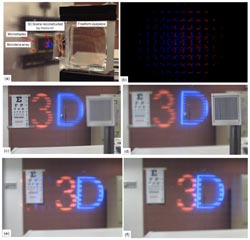Augmented reality is increasingly becoming… well … a reality. Smartphone apps can point out restaurants as you scan the street with your phone camera or even identify constellations when you point your phone at the night sky. And goggle-like devices—akin to Google Glass—that you wear on your head can superimpose computer-generated images onto your direct view of the physical world.
 Credit: Optics Express.
Credit: Optics Express.
But one major limitation of this kind of augmented reality (AR) technology is that moving back and forth between a 2-D image on the screen and a 3-D world in front of you causes eye strain, unless you’re looking at something far away. Now a new device developed by researchers at the University of Arizona in Tucson and the University of Connecticut in Storrs is making AR technology easier on the eyes for short-distance applications, too, by superimposing 3-D images instead of 2-D. The authors describe their new approach in a paper published today in The Optical Society’s (OSA) open-access journal Optics Express.
"Minimizing visual discomfort involved in wearing AR displays remains an unresolved challenge," says first author Hong Hua of the University of Arizona. "This work is making a significant step forward in addressing this important issue."
A lightweight, compact and high-performance Google Glass-like device—called an optical see-through head-mounted display (OST-HMD)—could potentially be “a transformative technology to redefine the way we perceive and interact with digital information,” Hua says. For example, it could one day allow a doctor to see computed tomography (CT) images overlaid on a patient's abdomen during surgery or provide a new way to train soldiers by incorporating 3-D virtual objects into real-life environments.
AR goggles for long-distance viewing don’t always cause eye strain; some of these eye-friendly designs are actively used for military applications. But short-distance designs—in which you would focus simultaneously on a 2-D screen and a 3-D world immediately around you—do cause visual discomfort, due to the so-called accommodation-convergence mismatch problem.
"The eyes are going back and forth between the screen and the three-dimensional scene away from the screen, causing conflicting depth perception cues and visual fatigue," Hua explains.
The device developed by Hua and her colleague Bahram Javidi of the University of Connecticut solves this problem for OST-HMDs by superimposing a 3-D image, rather than the standard 2-D image, onto the 3-D view of the real world.
To create the 3-D image, the researchers developed a technology called microscopic integral imaging display. In this technique, a tiny, high-resolution screen produces views from different perspectives of the 3-D image you want to superimpose. The views then combine to reconstruct a 3-D scene that's sent through a specially shaped optical lens—called a freeform eyepiece—and into the eye. The lens, based on an emerging technology known as freeform optics, also allows you to directly see the real-life scene before you.
The result is a superimposition of a 3-D image onto a direct view of reality, allowing you to see the virtual image as if it were a real, 3-D object in the physical space in front of you. There's no conflict in how your eyes focus, giving you a much more comfortable version of augmented reality, Hua says.
Still, much work remains before the device is ready for commercialization, she says. In particular, the researchers hope to improve the depth and spatial resolution, as well as the viewing angle of the microscopic integral imaging technology and the freeform eyepiece. But due to rapid improvements in commercially available optical and optoelectronic devices, the prospects for commercialization are promising, Javidi adds.
Paper: “A 3-D integral imaging optical see-through head-mounted display,” H. Hua and B. Javidi, Optics Express, vol. 22, Issue 11, pp. 13484-13491 (2014).